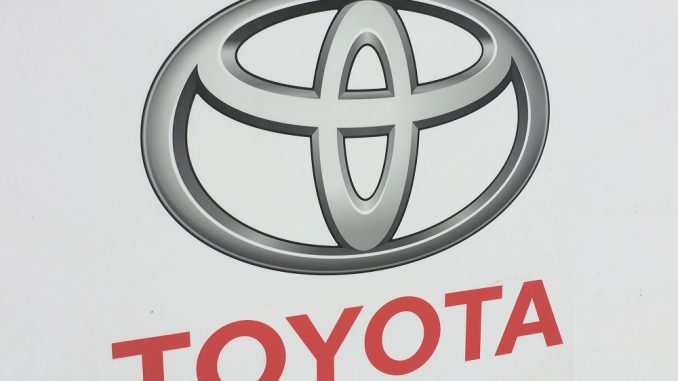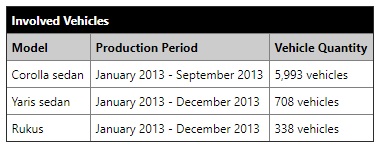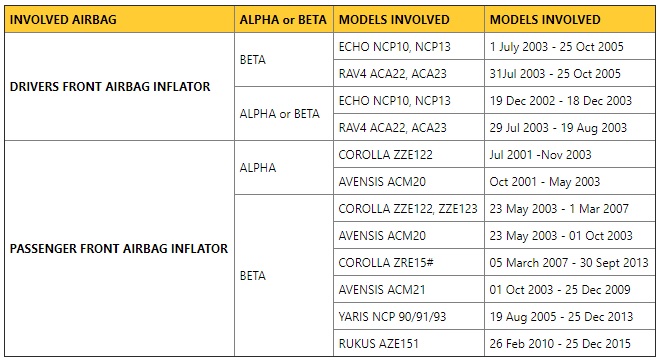
Toyota Australia will recall an additional 7,039 vehicles built between January and December 2013. This campaign involves Corolla sedan, Yaris sedan and Rukus models that have been installed with faulty Takata airbags.
In involved vehicles, as the airbag gets older, a combination of high temperatures and humidity can result in degradation of the inflator propellant.
If a vehicle with degraded propellant is involved in a collision, the airbag can go off with too much explosive force, causing sharp metal fragments to shoot out and kill or seriously injure people in the vehicle.
Affected vehicle owners will be initially notified by mail and asked to take their vehicle to their closest/preferred Toyota dealer for repair.
Replacement of the front passenger airbag inflator assembly will take approximately one to two hours. However, depending on the Dealer’s work schedule, it may be necessary to make a vehicle available for a slightly longer time. All rectification works will be carried out free of charge.
A full list of impacted vehicles and the production periods can be found below:
 Further information about the Takata airbag recalls is available at recalls.toyota.com.au
Further information about the Takata airbag recalls is available at recalls.toyota.com.au
The Toyota Recall Campaign helpline is also available on 1800 987 366 (Monday to Friday, 8am to 6pm AEST).
Toyota Australia sincerely regrets and apologises for any inconvenience caused by the Takata airbag recall.
Takata Airbag Recall Campaign – Q&A
[A] GENERAL INFORMATION ABOUT THE TAKATA CONDITION
Q1. What is the condition?
A1. In involved vehicles, the non-desiccated propellant that inflates the drivers or passengers front airbag (model dependent) could absorb moisture and degrade. This is either due to deficiencies during the manufacturing process (alpha), or after years of exposure to high humidity and fluctuating high temperatures (beta).
It is important to note, moisture intrusion in affected inflator propellant is a result of exposure to:
• high humidity; and
• fluctuating high temperatures.
This means the environment (operating location of the vehicle) is a factor, as is the age of a vehicle when assessing the risk of the condition occurring.
If the inflator propellant degrades due to moisture intrusion and the vehicle is involved in a collision, the airbag can go off with too much explosive force and rupture, causing sharp metal fragments to shoot out and kill or seriously injure people in the vehicle (refer Q11).
Q2: What is the function of the inflator?
A2: The inflator is a device contained within the airbag assembly. It contains a solid propellant which is ignited in the event airbag deployment is necessary. When ignited, the solid propellant expands into an inert gas, inflating the airbag.
Q3. What is a desiccant?
A3. Desiccants collect moisture present in their immediate environment, helping to limit moisture absorption of other nearby materials, such as propellant in an airbag inflator.
Desiccants are commonly placed inside the packaging of new goods to collect moisture. For example: pharmaceuticals, shoes and handbags.
Q4. Do affected Takata airbags contain desiccant?
A4. No. Affected Takata inflators contain non-desiccated propellant that results in the condition described in Q1.
Takata inflators with desiccated propellant are not affected by the current Takata airbag recalls for Toyota vehicles.
Q5. What happens if an airbag contains non-desiccated propellant and it degrades?
A5. If the propellant degrades substantially, the inflator can become over-pressurised and the airbag can go off with too much explosive force and rupture during airbag deployment, causing sharp metal fragments to shoot out and kill or seriously injure people in the vehicle.
Q6. Are there any warnings that this condition has occurred?
A6. No. There are no warnings that the condition described in question 1 exists.
[B] TOYOTA VEHICLES AFFECTED
Q7. Which Toyota vehicles are currently subject to an active Takata recall?
A7. Please refer to the table below for vehicles fitted with affected Takata airbag inflators (Alpha or Beta). You can also check the current status of a vehicle on Toyota’s VIN checker located at: recalls.toyota.com.au
 * Although the involved vehicles are within the above production ranges, not all vehicles in these production ranges were sold in the Australian market.
* Although the involved vehicles are within the above production ranges, not all vehicles in these production ranges were sold in the Australian market.
[C] ‘ALPHA’ AND ‘BETA’ TAKATA AIRBAGS
Q8. What is the difference between “alpha” inflators” & “beta” inflators?
A8. In the Compulsory Recall Notice the ACCC categorises airbags as “alpha” or “beta” type and focuses on the urgency to have vehicles with alpha airbags repaired (please refer Q9 below for further detail). The condition is further explained in Q1 above.
Q9. My vehicle is an affected vehicle. Am I able to continue to drive my vehicle until this recall is completed?
A9.
• If your vehicle is fitted with an alpha type Takata affected airbag (see Q1 above and table in answer to Q7 above for information about inflator type fitted)
You should immediately stop driving your vehicle and call a Toyota Dealer to organise transportation to the nearest repairer to have the airbag inflator replaced.
• If your vehicle is fitted with a beta type Takata affected airbag (see Q1 above and table in answer to Q7 above for information about inflator type fitted) please urgently contact your local/preferred Toyota Dealer to arrange repair.
Toyota owners can also check the status of their vehicle on Toyota’s VIN checker at recalls.toyota.com.au
For assistance locating a Toyota Dealer please visit toyota.com.au/find-a-dealer
Q10. Can I have my Takata airbag deactivated until it is repaired?
A10. At this stage, Toyota Australia is unable to provide advice on deactivating airbags in vehicles as this is a mandatory Australian Design Rule (ADR) requirement.
[D] TAKING ACTION
Q11. Have any accidents or injuries been reported as a result of this condition?
A11. Yes. There has been one incident involving a Toyota vehicle in Darwin that resulted in serious injury reported to Toyota Australia. It has also been reported that there was a death in Sydney as a result of an affected Takata airbag involving a non-Toyota vehicle.
Further, the ACCC have stated on their website that there have been 23 reported deaths and 230 injuries worldwide as a result of affected Takata airbags.
Q12. What is Toyota doing?
A12. Toyota takes the safety of our guests seriously and we are working hard to rectify all vehicles affected by the faulty Takata airbag inflators.
We have parts to complete all driver’s side airbag replacements and have sufficient parts to support passenger’s side airbag replacements based on current demand, with further parts scheduled for delivery.
Toyota is notifying, and responding to, owners of affected Toyota vehicles in a number of ways (including by mail, phone and email), to request that owners urgently take the following action:
• if the vehicle is fitted with an alpha type Takata affected airbag (see Q1 above and table in answer to Q7 above for information about inflator type fitted) immediately stop driving the vehicle and call a Toyota Dealer to organise transportation to the nearest repairer to have the airbag inflator replaced.
• if the vehicle is fitted with a beta type Takata affected airbag (see Q1 above and table in answer to Q7 above for information about inflator type fitted) urgently contact a local/preferred Toyota Dealer to arrange repair.
Toyota Dealers will arrange any required towing (alpha affected vehicles) and perform required rectification free of charge to the vehicle owner.
Q13. How long will the repair take?
A13. Most Takata airbag repairs take between 1 and 2 hours. Depending upon the Dealer’s work schedule, it may be necessary to make your vehicle available for a longer period of time.
Q14. What if an owner has additional questions or concerns?
A14. Owners with additional questions or concerns are asked to please contact their local/preferred Toyota Dealer in the first instance or the Toyota Recall Campaign Helpline on 1800 987 366 (8am to 6pm, Monday to Friday AEST). Please quote your 17 digit Vehicle Identification Number (VIN). Toyota owners can also check the status of their vehicle on Toyota’s VIN checker or access further information about the recalls at recalls.toyota.com.au
Concerns about the recall may also be reported to the ACCC at https://www.productsafety.gov.au/contact-us/for-consumers/make-an-enquiry
Q15. What is a VIN?
A15. A Vehicle Identification Number (VIN) is the string of 17 numbers and letters that a vehicle manufacturer assigns to an individual vehicle.
Q16. Where can I find my VIN?
A16. VIN number location varies by model. For information on how to find the VIN position specific to your vehicle, please search “vehicle identification number” in the alphabetical index at the rear of your Owner’s Manual.
Q17. What type of replacement airbag will be installed in my car?
A17. There are three different airbag types available dependant on model and location of airbag (driver or passenger).
The three types are:
– Takata desiccated airbag (refer Q3 above for a description of “what is a desiccant?”)
– Takata non-desiccated airbag (“like for like”- refer section E questions 22 and 23 below)
– Alternate part airbag inflator (refer Q18 below “what is an ‘alternate part’ airbag inflator?”)
Q18. What is an “alternate part” airbag inflator?
A18. An alternate part airbag inflator is one that has been engineered and manufactured by a different supplier (not Takata) using different propellants.
Q19. Am I entitled to a loan vehicle, vehicle towing or special repair arrangements?
A19.
Towing and special repair arrangements for alpha affected vehicles
• If your vehicle is fitted with an “alpha” airbag inflator (refer PART C above):
An offer will be made to tow the vehicle to the place of replacement or arrange for rectification on site (rectification on site subject to suitable work location).
Loan vehicle or special repair arrangements for all other affected vehicles
• A loan vehicle or alternate transportation arrangements will be made available to you upon request in all cases where:
o the vehicle is required to left at a dealership for more than 24 hours to replace the airbag.
• Under certain special circumstances, a loan vehicle or special repair arrangements will also be made available to you upon request if you are:
o elderly, infirm or disabled
o located more than 250 kilometres from the nearest Dealer
o located on an island which does not have a Toyota Dealer or another qualified place of replacement authorised by Toyota
Q20. Will Guests be compensated for any “Out of Pocket” expenses incurred?
A19. If you have any out of pocket expenses these will be evaluated on a case-by-case basis. Please discuss this with your Toyota Dealer who will refer this matter to Toyota Australia for review. Please note supporting documentation may be required.
Q21. What resources are available for Toyota guests?
A21.
• Toyota owners can check the status of their vehicle, as well as further information on the Takata recall campaign at: recalls.toyota.com.au
• Toyota owners can locate their local dealer at: www.toyota.com.au/find-a-dealer
• Toyota Recall Campaign Helpline: 1800 987 366 (8:00 am to 6:00 pm, Monday to Friday AEST)
A full list of all vehicles affected by the Takata airbag recalls in Australia is available on the ACCC website at: www.productsafety.gov.au
Concerns about the recall may also be reported to the ACCC at https://www.productsafety.gov.au/contact-us/for-consumers/make-an-enquiry

Leave a Reply